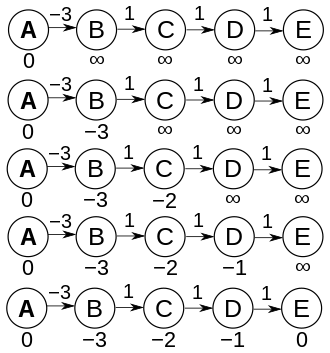
Bellman-Ford 的關鍵在於,對於一組中間相隔最遠有 n 個 edge 的 source node & destination node 來說,最多只需要對每個 edge 都 relax n 次,就一定可以求出他們之間的 shortest path。以上圖來說,只需要對中間那四條 edge relax 4 次,就可以得出 A 到 E 的 shortest path。
也就是說,對於一個有 n 個 node 的 graph 來說,因為任意兩個 node 的最遠距離不會超過 n - 1 條 edge,因此最多只需要對每條 edge 各 relax n - 1 次就可以求出任意的 single source shortest path。
function BellmanFord(list vertices, list edges, vertex source) is
// This implementation takes in a graph, represented as
// lists of vertices (represented as integers [0..n-1]) and edges,
// and fills two arrays (distance and predecessor) holding
// the shortest path from the source to each vertex
distance := list of size n
predecessor := list of size n
// Step 1: initialize graph
for each vertex v in vertices do
// Initialize the distance to all vertices to infinity
distance[v] := inf
// And having a null predecessor
predecessor[v] := null
// The distance from the source to itself is, of course, zero
distance[source] := 0
// Step 2: relax edges repeatedly
repeat |V|−1 times:
for each edge (u, v) with weight w in edges do
if distance[u] + w < distance[v] then
distance[v] := distance[u] + w
predecessor[v] := u
// Step 3: check for negative-weight cycles
for each edge (u, v) with weight w in edges do
if distance[u] + w < distance[v] then
predecessor[v] := u
// A negative cycle exists; find a vertex on the cycle
visited := list of size n initialized with false
visited[v] := true
while not visited[u] do
visited[u] := true
u := predecessor[u]
// u is a vertex in a negative cycle, find the cycle itself
ncycle := [u]
v := predecessor[u]
while v != u do
ncycle := concatenate([v], ncycle)
v := predecessor[v]
error "Graph contains a negative-weight cycle", ncycle
return distance, predecessor至於 detect negative cycle,請見 use Bellman-Ford to Detect Negative Cycle。